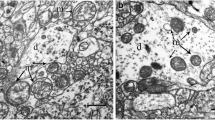Abstract
The involvement of the calcium and phosphoinositide intracellular regulatory systems in the molecular-cellular mechanisms of adaptation of the brain to hypoxia induced by transient anoxia were studied in slices of rat olfactory cortex. Anoxia lasting 2 min initiated the development of moderate but stable activation of intracellular regulatory systems during the reoxygenation period, with increases in binding of Ca2+ to intracellular hydrophobic domains and increases in the level of polyphosphoiositide metabolism. During this period, cells in the slices released neuromediator factors into the perfusion fluid; transfer of these to recipient slices induced similar changes in the activities of intracellular regulatory system components in the recipient slices. After anoxia lasting 10 min, NMDA-mediated pathogenic hyperactivity of the calcium and phosphoinositide systems developed. Preliminary moderate activation of these systems by transient anoxia or neuromodulator factors released by cells in response to transient anoxia prevented disruption of intracellular regulatory system activity induced by subsequent longer-lasting anoxia.
Similar content being viewed by others
References
M. I. Mityushov, N. A. Emel'yanov, A. A. Mokrushin, I. A. Voiner, and T. R. Bagaeva,Living Brain Slices as a System for Neurophysiological and Neurochemical Studies [in Russian], Nauka, Leningrad (1986)
M. O. Samoilov, “Basic molecular-cellular mechanisms of adaptive brain reactions”Ros. Fiziol. Zh. im. I. M. Sechenova,81, No. 8, 3–11 (1995).
M. O. Samoilov and A. A. Mokrushin, “Molecular-cellular mechanisms of the ‘volume’ transmission of information in the brain,” in:Report of the Scientific Council of the Russian Academy of Medical Sciences in Experimental, and Applied Physiology [in Russian], Moscow (1996), Vol. 6, pp. 12–31.
M. O. Samoilov and A. A. Mokrushin, “Peptide modulation of synaptic plasticity induced by anoxia,”Dokl. Ros. Akad. Nauk,357, No. 4, 565–567 (1997).
M. O. Samoilov, D. G. Semenov, and V. N. Maiorov, “Dynamics of the content of bound calcium in the cerebral cortex after termination of the oxygen supply,”Fiziol. Zh. SSSR,70, No. 5, 601–608 (1984).
M. O. Samoilov, D. G. Semenov, E. I. Tyul'kova and E. A. Bolekhan, “The effects of transient anoxia on the mechanisms of intracellular signal transduction in the cerebral cortex,”Ros. Fiziol. Zh. im. I. M. Sechenova,80, No. 11, 37–43 (1994)
M. O. Samoilov, D. G. Semenov, E. I. Tyul'kova, and E. A. Bolekhan, “Molecular-cellular mechanisms of the protective effects of transient anoxia,”Ros. Fiziol. Zh. im. I. M. Sechenova,80, No. 12, 71–75 (1994).
D. G. Semenov and S. I. Ermolin, “Automation of microfluorimetric measurements of membrane-bound calcium contents in the cerebral cortex of the cat,”Ros. Fiziol. Zh. im. I. M. Sechenova,79, No. 9, 114–116 (1993).
D. G. Semenov, E. I. Tyul'kova, and M. O. Samoilov, “Intracellular mechanisms of glutamatergic and cholinergic signal transduction in the cerebral cortex,”Ros. Fiziol. Zh. im. I. M. Sechenova,81, No. 8, 51–55 (1995).
E. I. Tyul'kova, D. G. Semenov and M. O. Samoilov, “The involvement of the calcium and phosphoinositide intracellular regulatory systems in the adaptation of neurons in brain slices to in vitro hypoxia,”Byull. Éksp. Biol. Med.,125, No. 3, 259–263 (1998).
E. I. Tyul'kova and A. Yu. Sledkov, “Changes in the polyphosphoinoisitide response induced by various neuromediators after exposure to helium-oxygen mixtures at increased pressure,”Fiziol. Zh. SSSR,78, No. 3, 73–77 (1992).
H. Abe, T. S. Nowak Jr., “Gene expression and induced ischemic tolerance following brief insults,”Acta Neurobiol. Exp.,56, 3–8 (1996).
J. J. Baldassare, P. A. Henderson, G. J. Fisher, “Isolation and characterization of one soluble and two membrane-associated forms of phosphoinositide-specific phospholipase C from human platelets,”Biochemistry,28, No. 14, 6010–6016 (1989).
D. W. Choi and D. M. Hartley, “Calcium and glutamate-induced cortical neuronal death,” in:Molecular and Cellular Approaches to the Treatment of Neurological Disease, S. G. Waxman (Ed.), Raven Press, New York (1993), pp. 23–34.
K. Domanska-Janik and B. Zabolonska, “Protein kinase C as an early and sensitive marker of ischemia-induced progressive neuronal damage in gerbil hippocampus,”Mol. Chem. Neuropath,20, 111–124 (1993).
A. Gage and P. Stanton, “Hypoxia triggers neuroprotective alterations in hippocampal gene expression via a heme-containing sensor,”Brain Res.,719, 172–178 (1996).
C. Hammond, V. Crepel, H. Gozlan, and Y. Ben-Ari, “Anoxic LTP sheds light on the multiple facets of NMDA receptors,”TINS,17, 497–503 (1994).
K. Kitagawa, M. Matsumoto, and M. Tagaya, “Ischemic tolerance' phenomenon found in the brain,”Brain Res.,528, No. 1, 21–24 (1990).
J. Schwartz and S. Greenberg, “Molecular mechanisms for memory: second messnger-induced modification of protein kinases in nerve cells,”Ann. Rev. Neurosci.,10, 459–476 (1987).
A. Shurr, K. Reid, M. Tseng, K. West, and B. Rigor, “Adaptation of adult brain tissue to anoxia and hypoxia in vitro,”Brain Res.,347, No. 2, 244–248 (1986).
P. Zielonka, E. Salinska, P. Foltynski, and J. W. Lazarewicz, “Application of a quartz fibreoptic probe for the monitoring of changes in intracellular Ca2+ the rat hippocampal slice,”Pol. J. Med. Physics and Engin.,2, 49–58 (1996).
Author information
Authors and Affiliations
Additional information
Translated from Rossiiskii Fiziologicheskii Zhurnal imeni. I. M. Sechenova, Vol. 85, No. 1, pp. 139–148, January, 1999.
Rights and permissions
About this article
Cite this article
Semenov, D.G., Tyul'kova, I.I., Samoilov, M.O. et al. Involvement of intracellular regulatory systems in the adaptive effects of transient anoxia in vitro. Neurosci Behav Physiol 30, 357–363 (2000). https://doi.org/10.1007/BF02471790
Received:
Revised:
Issue Date:
DOI: https://doi.org/10.1007/BF02471790



